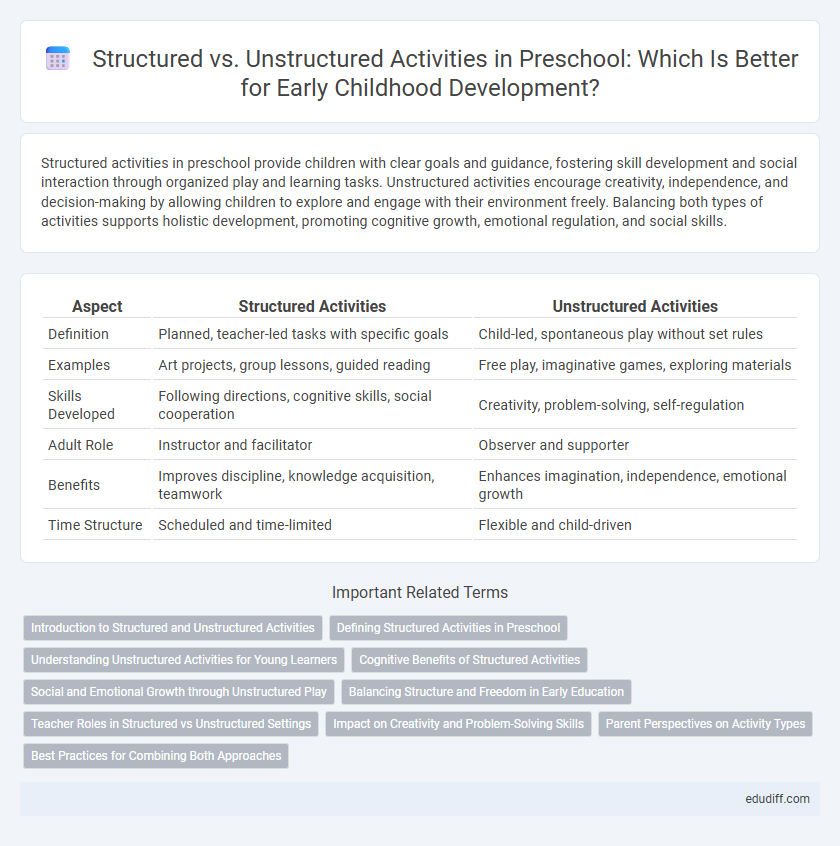Structured activities in preschool provide children with clear goals and guidance, fostering skill development and social interaction through organized play and learning tasks. Unstructured activities encourage creativity, independence, and decision-making by allowing children to explore and engage with their environment freely. Balancing both types of activities supports holistic development, promoting cognitive growth, emotional regulation, and social skills.
Table of Comparison
| Aspect | Structured Activities | Unstructured Activities |
|---|---|---|
| Definition | Planned, teacher-led tasks with specific goals | Child-led, spontaneous play without set rules |
| Examples | Art projects, group lessons, guided reading | Free play, imaginative games, exploring materials |
| Skills Developed | Following directions, cognitive skills, social cooperation | Creativity, problem-solving, self-regulation |
| Adult Role | Instructor and facilitator | Observer and supporter |
| Benefits | Improves discipline, knowledge acquisition, teamwork | Enhances imagination, independence, emotional growth |
| Time Structure | Scheduled and time-limited | Flexible and child-driven |
Introduction to Structured and Unstructured Activities
Structured activities in preschool involve guided learning experiences with specific goals, such as puzzles, group reading, or organized games that promote cognitive and social development. Unstructured activities allow children the freedom to explore, play, and express creativity without predetermined outcomes, fostering imagination and problem-solving skills. Balancing both structured and unstructured activities supports holistic growth by addressing diverse developmental needs in early childhood education.
Defining Structured Activities in Preschool
Structured activities in preschool involve teacher-led tasks with specific goals, such as guided play, circle time, and themed lessons designed to develop cognitive, social, and fine motor skills. These activities follow a clear schedule and curriculum to promote early learning standards and classroom routines. Emphasizing consistency and targeted skill development, structured activities support foundational academic readiness and behavioral growth.
Understanding Unstructured Activities for Young Learners
Unstructured activities in preschool environments foster creativity, social skills, and problem-solving by allowing young learners to explore freely without rigid guidelines. These activities promote self-directed play, which is crucial for cognitive and emotional development as children engage with peers and materials at their own pace. Emphasizing unstructured experiences supports language acquisition, imagination growth, and adaptability essential for early childhood learning.
Cognitive Benefits of Structured Activities
Structured activities in preschool significantly enhance cognitive development by promoting skills such as problem-solving, memory retention, and attention control. These activities provide a clear framework that helps children understand sequences, follow instructions, and engage in goal-oriented tasks, fostering critical thinking and executive function. Regular participation in structured learning environments also supports language acquisition and social cognition by integrating guided interaction and feedback.
Social and Emotional Growth through Unstructured Play
Unstructured play in preschool settings fosters social and emotional growth by encouraging creativity, problem-solving, and empathy as children navigate imaginative scenarios and peer interactions without rigid guidelines. This form of play supports the development of self-regulation, emotional resilience, and communication skills by allowing children to express feelings freely and negotiate roles within their social groups. Research highlights that unstructured activities promote stronger social bonds and enhance emotional intelligence, which are critical for early childhood development.
Balancing Structure and Freedom in Early Education
Balancing structured and unstructured activities in preschool promotes cognitive and social development by combining guided learning with creative exploration. Structured activities, such as alphabet games and number puzzles, provide foundational skills and routine, while unstructured play encourages imagination, problem-solving, and emotional growth. Early education programs that integrate both approaches support well-rounded development and foster a love for lifelong learning.
Teacher Roles in Structured vs Unstructured Settings
In preschool settings, teachers in structured activities act as facilitators by guiding learning objectives and maintaining clear routines that promote skill development and cognitive growth. In contrast, during unstructured activities, teachers adopt a more observational role, encouraging children's creativity, social interaction, and independence by allowing free exploration without direct intervention. This balance ensures that children benefit from both directed learning experiences and spontaneous play, supporting diverse developmental milestones.
Impact on Creativity and Problem-Solving Skills
Structured activities in preschool provide clear guidelines and goals that enhance children's problem-solving abilities by fostering logical thinking and discipline. Unstructured activities promote creativity by allowing free exploration and imaginative play, encouraging original ideas and flexible thinking. Balancing both types of activities yields significant improvements in cognitive development, nurturing innovative problem-solvers equipped with diverse creative skills.
Parent Perspectives on Activity Types
Parents often prefer structured activities in preschool settings because they provide clear learning goals and promote skill development such as literacy and numeracy. However, many recognize the value of unstructured play for fostering creativity, social skills, and emotional regulation in young children. Balancing both activity types aligns with parental expectations for holistic early childhood education.
Best Practices for Combining Both Approaches
Combining structured and unstructured activities in preschool settings enhances cognitive, social, and emotional development by balancing guided learning with creative play. Best practices include scheduling predictable routine times for structured tasks like literacy and numeracy exercises alongside flexible periods that encourage free exploration and imaginative play. This dual approach supports skill acquisition while fostering independence, problem-solving, and social interaction among young children.
Structured activities vs Unstructured activities Infographic

 edudiff.com
edudiff.com